In Ethereum, smart contracts are account-holding objects on the blockchain. They contain code and storage, can interact with other contracts, and send and receive “ether” to and from other accounts (ether is the digital currency used on the Ethereum blockchain).
Ethereum smart contract are immutable and often deal with valuable digital assets. This gives a strong incentive to get the contract logic right the first time.
Alloy
Alloy is a declarative specification language developed by Daniel Jackson and his team at the MIT. It is well suited to express the logical model underlying a program. The “Alloy Analyzer” allows the programmer to explore the model interactively and to check complex logical assertions automatically.
The Alloy approach is considered a “lightweight” method because it is intended to provide a fully automated analysis. Think of it as property-based testing on steroids.
Example: Voting
Solidity is the most popular programming language targeting the Ethereum Virtual Machine. In the Solidity documentation, there is an introductory example contract for voting. This contract does not involve money, but it is nevertheless an interesting target for analysis.
Once a voting contract is created by a chairperson (represented by her Ethereum address), there are three public functions that change the current state. These public functions may, in principle, be invoked by anyone at any time.
-
giveRightToVote:// Give `voter` the right to vote on this ballot. // May only be called by `chairperson`. function giveRightToVote(address voter) public { require((msg.sender == chairperson) && !voters[voter].voted && (voters[voter].weight == 0)); voters[voter].weight = 1; } -
delegate: let somebody else vote for youEverybody can only call this once. Subsequent calls raise an exception.
-
vote: cast your vote for one of the proposalsAgain, this can only be called once.
The currently leading proposal can be queried by a fourth public function.
For details, please take a look at the full source code. It is well commented.
Creating the Model
Before we can analyze the contract behavior, we need to create a matching Alloy model. The goal is to create a formal specification which can be checked for certain properties.
Warning: even if your specification is perfect, you still need to verify that your contract actually implements it. See Security Considerations in the Solidity documentation for common pitfalls.
Alloy as a language is a very different from Solidity. While Solidity is object-oriented and imperative, Alloy is declarative and feels like a mixture of logic and functional programming. Translating the contract can be a worthwile exercise in itself, leading to a deeper understanding of its behavior.
The gist of the full model is explained in the subsequent sections.
Entities and Relationships
There are three kinds of entities we are interested in in this model: addresses, proposals and ballots. Addresses represent Ethereum addresses. We do not care about the details of addresses. The only thing that matters is their identity. So we define addresses as an empty signature:
sig Address {}
Signatures are similar to classes in object-oriented languages. A signature defines a set of objects and, optionally, relationships to other signatures.
sig Proposal {}
The details of proposals also don’t matter for our model. The only important thing is that there is a set of proposals that can be voted on.
sig Ballot {
chairperson: Address,
voted: set Address,
vote: Address -> lone Proposal,
delegate: Address -> lone Address,
weight: Address -> lone Int,
count: Proposal -> one Int
}
The only non-trivial entity in this model is the ballot. It has a number of relationships that are used to keep track of the current voting situation. A ballot captures the whole current state.
A ballot has exactly one chairperson. It is represented by the address of the user that created the ballot.
This is equivalent to the chairperson field in the Solidity example.
The voted set is used to remember which addresses already voted or delegated.
This set fulfills the same purpose as the voted field in the “Voter” struct in Solidity.
vote is a relationship from addresses to proposals. Relationships play the same role as mappings or dictionaries in other languages.
The multiplicity of the vote relationship is 0..1 as indicated by the lone keyword.
Every address can vote for at most one proposal.
delegate is similar. It is used to remember who delegated to whom.
weight determines how much the vote of an address will count. Only addresses that have been
delegated to can have a weight greater than 1.
Finally, count is the result of the vote so far. The keyword one enforces that every proposal must
have a exactly one current count. Initially the count will be 0 for all proposals.
Compared to the data structure in the Solidity example, our Alloy data structure is flattened. We could have chosen a nested structure in Alloy, too. But in Alloy, all data is immutable (similar to pure functional programming languages), and working with flat structures is easier in this case.
Transitions
In the initial state of a ballot, all relationships are empty, except for the chairperson which is set to the address of the contract creator, and the vote count which is initialized to 0 for every proposal.
To define valid transitions from the initial state to subsequent states, we define some predicates. A predicate contains a sequence of constraints. When a predicate is called, these constraints are applied to the given parameters. Constraints can never contradict other constraints. As a consequence, we cannot change any data, we can only add additional information.
For example, to add voting rights for a new voter:
pred giveRightToVote(sender: Address, b, b': Ballot, voter: Address) {
// preconditions
sender = b.chairperson
voter not in b.voted
voter not in b.weight.Int // voter must not have a weight from before
// copy unchanged relations
b'.voted = b.voted
b'.count = b.count
b'.chairperson = b.chairperson
b'.delegate = b.delegate
b'.vote = b.vote
// add a tuple (voter, 1) to the weight relationship
b'.weight = b.weight + voter -> 1
}
The initial state is given as b. The new state is returned as b'.
This predicate is quite similar to the Solidity example function with the same name.
There are to important differences, though:
- We need to add some additional code to copy all unchanged fields from
btob'. Otherwise, those fields would be unconstrained inb'and would be filled with arbitrary values during analysis. - In Solidity, we distinguish between assertions, using the
requirekeyword, and the actual code. In Alloy, on the other hand, the whole predicate consists of constraints. There is no difference between requiring a certain state and actively setting the state. (As is typical for logic programming languages.)
Enforcing only Legal States
We want to constrain the state space to legal ballots. Only ballots that can be created from the initial state by applying well-defined transitions should be allowed.
This can be achieved be enforcing an ordering on the set of ballots and defining the legal transitions:
open util/ordering[Ballot] as ord
fact traces {
// the first state is a freshly created ballot
some chairperson: Address | freshBallot[chairperson, ord/first]
// define all legal state transitions
all b: Ballot - ord/last |
let b' = b.next |
(some sender, voter: Address | giveRightToVote[sender, b, b', voter])
or (some sender, to: Address | delegate[sender, b, b', to])
or (some sender: Address, prop: Proposal | vote[sender, b, b', prop])
}
We are using the built-on ordering module to impose an ordering on the Ballot instances
and define some “facts”. In Alloy, facts are constraints that always hold.
First we define that the first ballot is always a “fresh ballot” created by
some chairperson represented by an address. freshBallot is a simple predicate
that initializes the fields. By using an existential quantification of the form
some chairperson: Address | <constraint>
we ensure that the Alloy Analyzer is free to choose any available chairperson when creating examples.
Then, for all ballots except for the last one, we define the relationship between a ballot and its
successor b.next.
There are three possible transitions, connected using the or keyword:
-
Giving someone the right to vote, using the previously defined predicate
giveRightToVote. -
Delegating the vote to somebody else. The definition of the
delegatepredicate is not shown here but can be seen in the full listing. -
Voting for a proposal, using the predicate
vote(also not shown here).
Again, we use existential quantification, to allow for arbitrary senders, voters and proposals.
Analysis: Interesting Properties
An important property we want for our model is: the sum of all votes can never be greater than the sum of all weights that were distributed by the chairperson. It may be smaller when not all votes have been cast yet, but it can never be greater in a legal ballot.
In Alloy, we can express this as an assertion:
assert sumOfCountsNotMoreThanWeights {
all b: Ballot |
let counts = sum p: Proposal | b.count[p] |
let weights = sum a: Address | b.weight[a] |
counts <= weights
}
We can automatically check this assertion with the check command.
> check sumOfCountsNotMoreThanWeights
Executing "Check sumOfCountsNotMoreThanWeights"
Sig this/Address scope <= 3
Sig this/Proposal scope <= 3
Sig this/Ballot scope <= 3
Sig this/Ballot forced to have exactly 3 atoms.
No counterexample found. Assertion may be valid. 203ms.
By default, the Alloy Analyzer chooses a scope of 3, i.e. it analyzes all scenarios with at most 3 adresses, 3 proposals and 3 ballots. Within this scope, no counterexample has been found.
In this case, the default scope is too small. With only 3 ballots, the scenarios cannot even contain all 3 types of legal transitions! Let’s increase the number of ballots to 6:
> check sumOfCountsNotMoreThanWeights for 3 but 6 Ballot
Executing "Check sumOfCountsNotMoreThanWeights for 3 but 6 Ballot"
Sig this/Address scope <= 3
Sig this/Proposal scope <= 3
Sig this/Ballot scope <= 6
Sig this/Ballot forced to have exactly 6 atoms.
No counterexample found. Assertion may be valid. 16245ms.
The analysis has taken a lot more time, but still no counterexample has been found. Of course, we could start an analysis with an even larger scope. But that does not seem to be necessary. It is reasonable to assume that the assertion always holds. We rely on the “small scope hypothesis”: that a high proportion of bugs can be found by testing a program for all test inputs within some small scope.
Some other assertions that were successfully checked:
- There can never be a voter that has both voted and delegated.
- It does not matter whether we delegate to someone before or after she has voted. (Both cases are handled in the
delegatefunction.) - There can never be a loop of delegation, i.e. a situation were someone directly or indirectly delegates his vote to himself. The formal definitions of these assertions can be seen in the full model source.
No problems were found by checking the properties we could think of. The Solidity voting example seems to be pretty solid.
Interactive Exploration
Still, so far we haven’t taken a look at any instances of our model. How can we have confidence that our model actually makes sense?
This is where interactive exploration comes into play. We can tell the Alloy Analyzer to generate example instances satisfying all model constraints, and we can then explore those instances with a graphical inspector.
Let’s take a look at an example.
In the initial state Ballot0, there are three proposals and three addresses. So far nobody has voted yet, in fact, nobody has the right to vote. Address2 has been selected to be the chairperson:
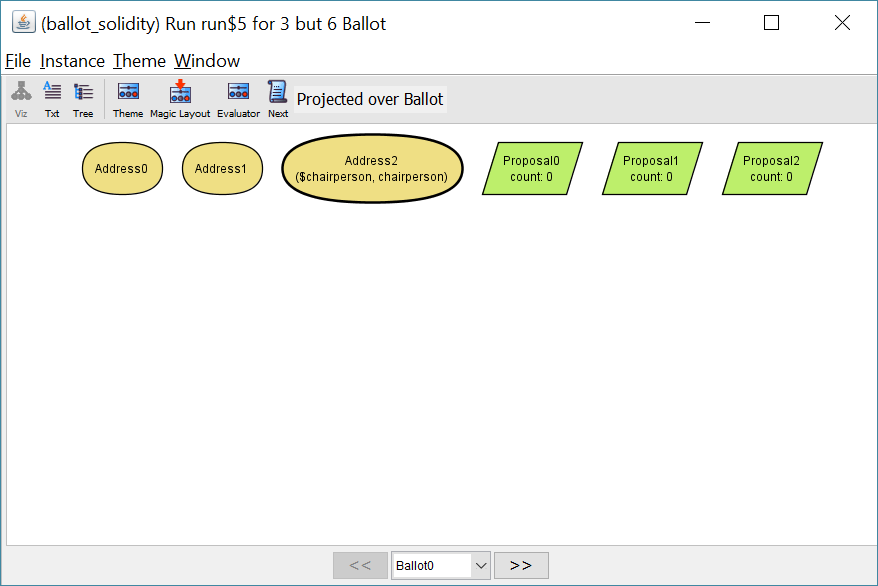
In the next state, Address1 has been given the right to vote. Her weight is now 1:
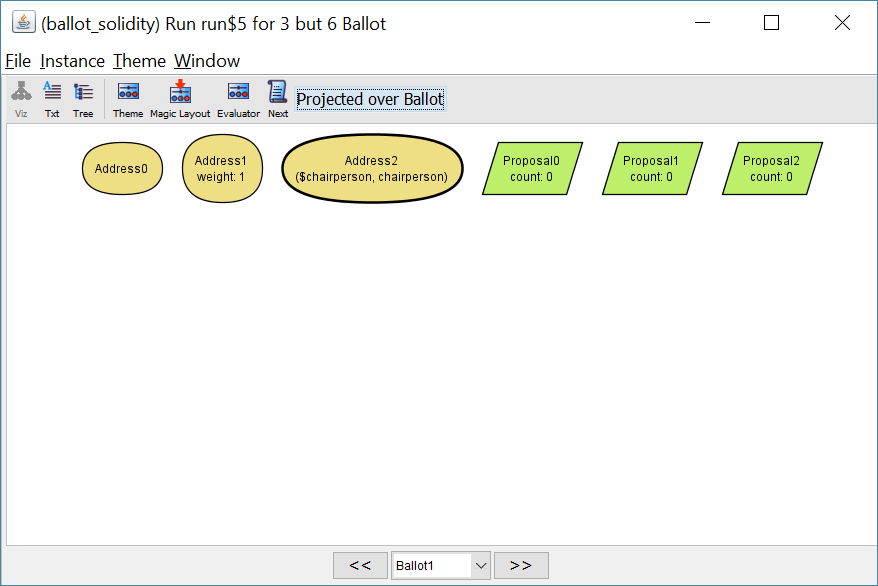
Address1 has delegated her vote to Address0. She cannot vote again because the address is now in the voted set.
Address0 has received the delegated weight 1:
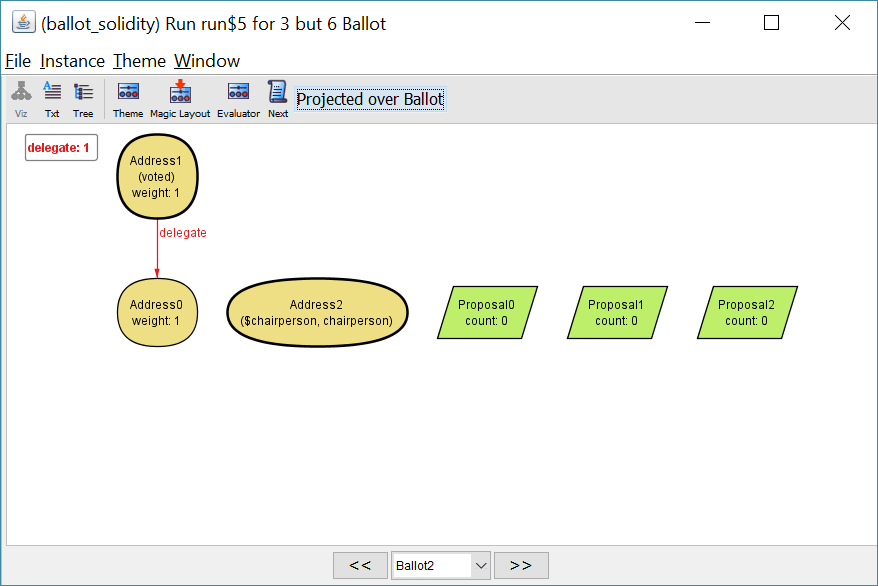
Address2 also has received the right to vote:
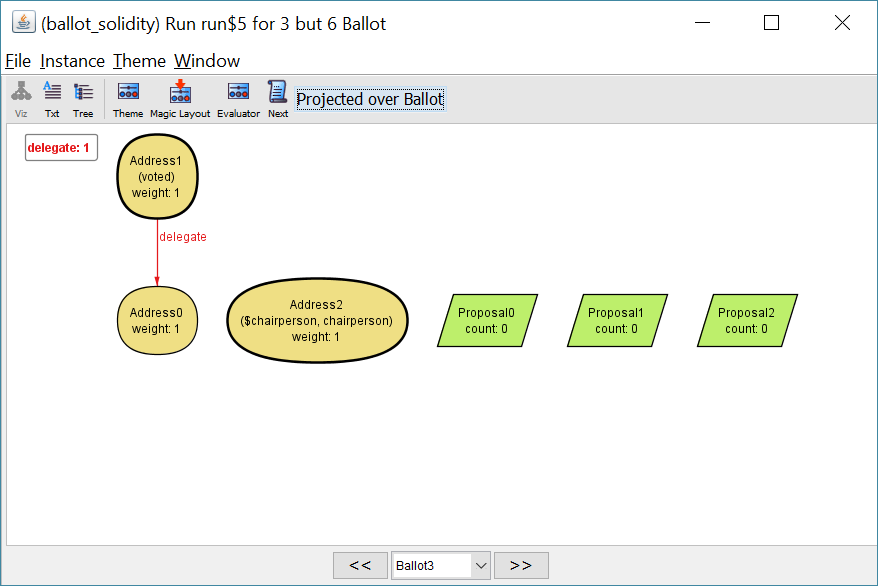
Address0 has voted for Proposal0:
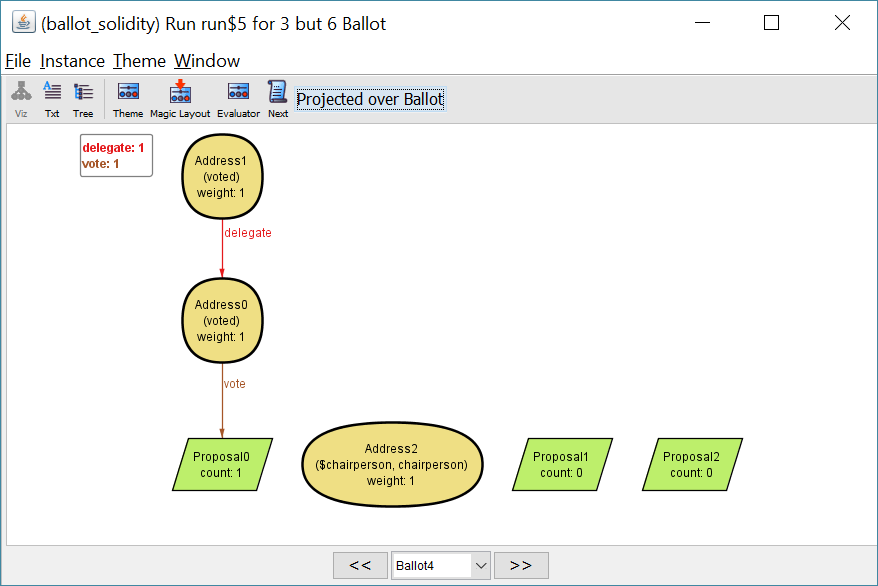
Finally, Address2 has voted for Proposal1:
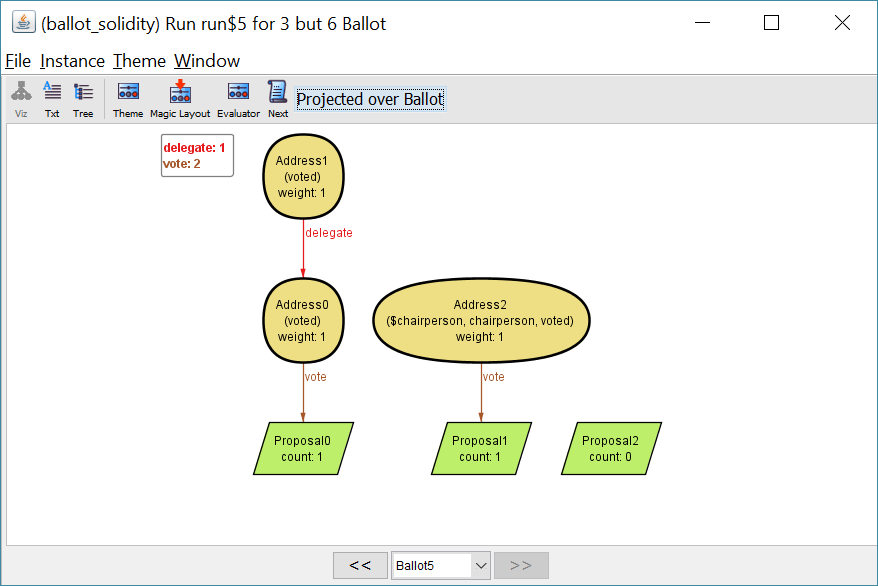
This looks like a reasonable sequence of events. Our model seems to generate meaningful instances. The only slightly suprising observation is that a vote can be delegated to a person without the right to vote.
A Minor Problem with the Example Contract
When looking at further instances, a curious situation attracts attentions.
In the first state, there are three addresses and one proposal. So far, only Address1 has the right to vote:
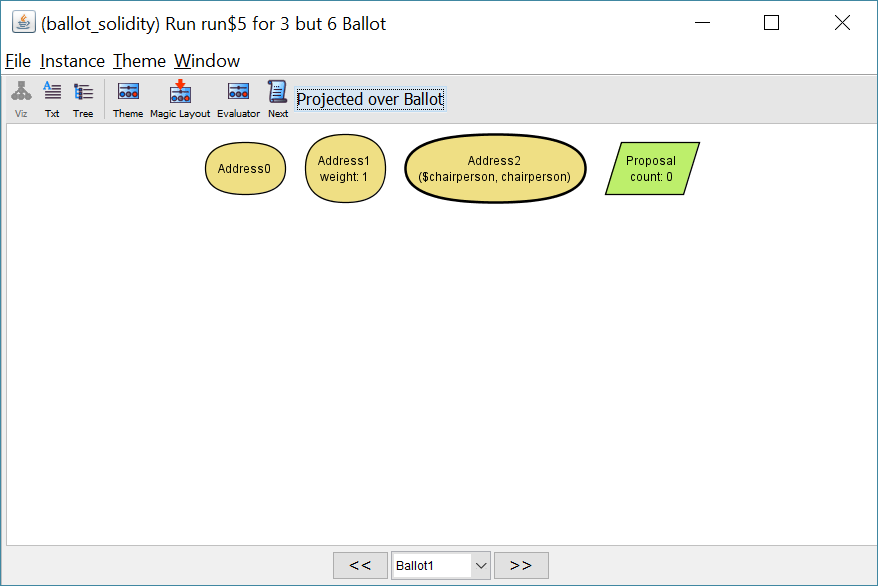
Now, this is weird. Address2 (which also happens to be the chairperson) has delegated her non-existing vote to Address1:
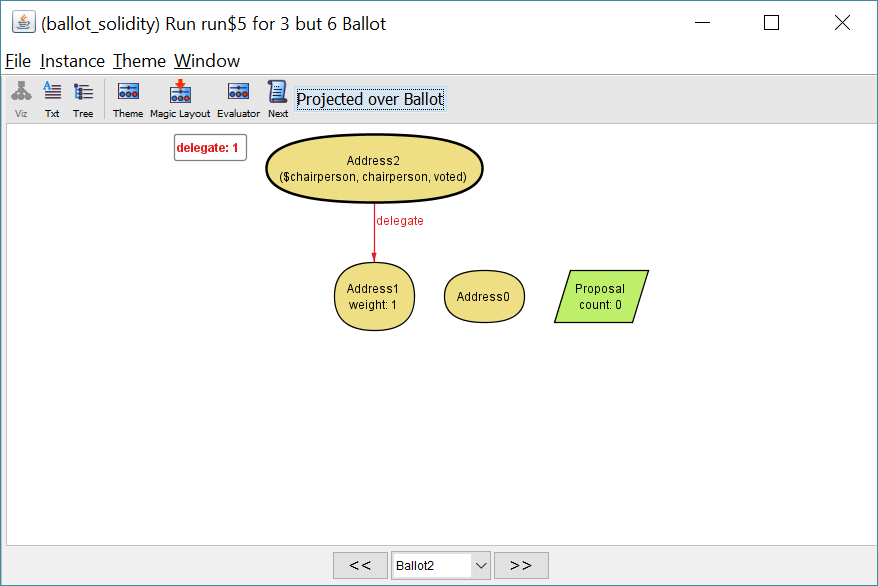
This is almost certainly an error situation. Why would Address2 call the delegate function when there is nothing to delegate?
Such a call to delegate should probably fail. We can improve the Solidity example by adding a precondition to the delegate function:
require(sender.weight > 0)
We might be tempted to dismiss this problem. After all, the normal sequence of events is that the chairperson first distributes voting rights and only then people start to vote and delegate.
However, in distributed computing, especially in a public setting, we should be prepared for every possible sequence of events, not only for those which intuitively make sense. This is where the ability to create all possible sequences automatically by defining the legal transitions can be very valuable.
Summary
Although analyzing the Solidity example voting contract didn’t reveal any major problems, the analysis was not a waste of time. It has increased our confidence in the correctness of the contract. In fact, now we know that some invariants always hold within the analyzed scope.
So – should you validate your smart contracts with lightweight formal methods?
The initial investment is quite steep: learning a system like Alloy takes time. In the long term it is most likely a worthwile undertaking for any software developer.
Smart contracts are typically less complex than large software systems (like operating systems or complex business applications). This makes them more amendable for applying formal methods.
Once a developer is familiar with Alloy, an analysis like this takes about half a work day. For high-stake contracts, the benefit can be very significant. I feel confident that lightweight formal methods and smart contracts can be an excellent match.
Sources
- https://www.ethereum.org/greeter
- https://en.wikipedia.org/wiki/Alloy_(specification_language)
- http://solidity.readthedocs.io/en/develop/solidity-by-example.html
- http://solidity.readthedocs.io/en/latest/security-considerations.html
For learning Alloy, take a look at
- the Alloy tutorial, and
- the book Software Abstractions by Daniel Jackson